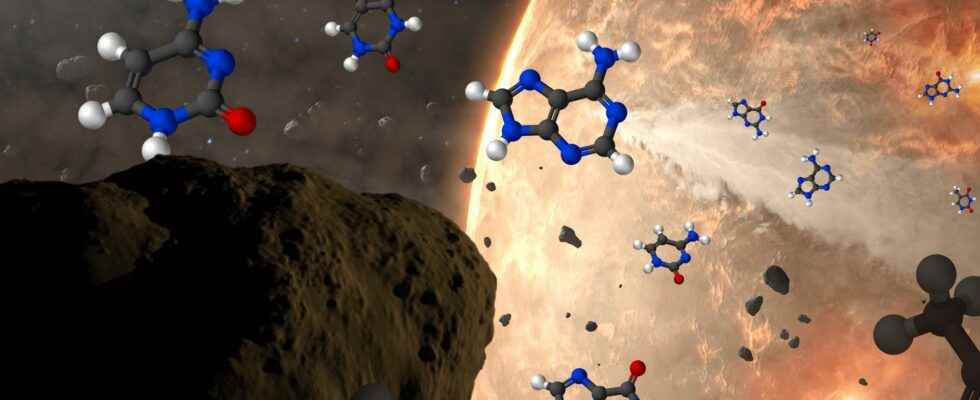You will also be interested
[EN VIDÉO] Searching for traces of life on Enceladus This moon of Saturn is home to underground oceans supporting a possible form of life.
Where does the life on earth ? Was it first brought in by external elements or did it develop directly on site? To answer, scientists are looking for traces of life on asteroids, which during their passage on Earth would have brought the elementary bricks of life. In particular, molecules carbon-based (C), hydrogen (H), oxygen (O) and nitrogen (NOT). Together, these four elements form a large part of the molecules that make up living things.
Five nitrogenous bases encode genetic information
L’DNAfor example, takes the form of a double helix characterized by the alternation of four nitrogen basesWhere nucleobases : adenine and guanine which belong to the family of purinesand cytosine and thymine which themselves belong to the pyrimidines. L’RNAmeanwhile, forms only a helix, and among the four nitrogenous bases that compose it, theuracil replaces thymine with respect to DNA.
Until now, only three of the five known nitrogenous bases had been found on asteroids of the Solar System: cytosine and thymine were missing each time. In a study published in the journal type communications, on April 26, an international team of researchers analyzed in detail the contents of three meteorites carbon-rich: Murchison, which landed in Australia in 1969, Murray which landed in Kentucky in 1950, and Tagish Lake which fell in British Columbia in 2000.
The last two bases are more fragile and require advanced techniques
Elusive until now, but this time the pyrimidines have indeed been found in each of the three meteorites. Why have they remained undetectable before today? “Given that purines and pyrimidines can be synthesized in extraterrestrial environments, as demonstrated by our own study, one would expect to find a great diversity of these organic molecules in meteorites,” wondered Yasuhiro Oba, lead author of the study and researcher at Hokkaido University.
In their study, the researchers provide the answer: their detection method differed from the previous ones by its less destructive process. In fact, previous studies consisted of immersing extracts of meteorites in bathsformic acid very hot, in order to extract molecules. L’acid being very reagent and the two nitrogenous bases having more fragile structures than their counterparts, the latter then very probably degraded.
This time the team used “chromatography liquid high performance [qui consiste à séparer les différents composants d’un échantillon selon leur affinité à différentes phases] coupled to the mass spectrometry at high resolution electrospray ionization [qui permet de détecter des molécules et leurs structures selon leur masse] », explains the study. These two techniques use less destructive chemical compounds, allowing the structure of cytosine and thymine molecules to be preserved.
If they could bring it to Earth, they could bring it to other planets
It remains to be seen when all these nucleobases were created, which the researchers answer in their study: most likely during the first moments of the Solar System, around 4 billion years ago. More specifically, they “could have been generated by photochemical reactions prevailing in the interstellar medium and later incorporated into asteroids during the formation of the Solar System”explains the study.
More than a proof of the life brought by asteroids, this research proves at least that they can give rise to chemical reactions thrusts, which create these building blocks. But, even more, this discovery revives the hope of discovering life elsewhere than on Earth. Because if asteroids brought these elements to Earth, then in other star systems the same phenomenon is very likely.
In the future, it’s the asteroids Ryugu and Bennu which will be targeted, thanks in particular to the missions Osiris-Rex of the Nasa and Hayabusa 2 of the Jaxawho respectively collected samples from Bennu and Ryugu.
Interested in what you just read?
